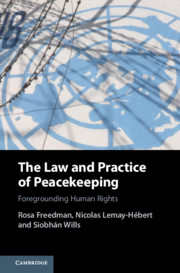Book contents
- The Law and Practice of Peacekeeping
- The Law and Practice of Peacekeeping
- Copyright page
- Contents
- 1 Introduction
- 2 A Political History of UN Involvement in Haiti
- 3 Integrating Human Rights Norms into UN Peacekeeping Practice
- 4 UN Immunities and Human Rights
- 5 The Cholera Epidemic
- 6 Sexual Exploitation and Abuse
- 7 UN Peacekeepers’ Use of Deadly Force to Maintain Law and Order
- 8 Conclusion
- Index
8 - Conclusion
Published online by Cambridge University Press: 28 May 2021
- The Law and Practice of Peacekeeping
- The Law and Practice of Peacekeeping
- Copyright page
- Contents
- 1 Introduction
- 2 A Political History of UN Involvement in Haiti
- 3 Integrating Human Rights Norms into UN Peacekeeping Practice
- 4 UN Immunities and Human Rights
- 5 The Cholera Epidemic
- 6 Sexual Exploitation and Abuse
- 7 UN Peacekeepers’ Use of Deadly Force to Maintain Law and Order
- 8 Conclusion
- Index
Summary
This book has focused on three aspects of MINUSTAH’s human rights responsibilities: (i) accountability for the outbreak and spread of cholera, (ii) sexual exploitation and abuse by peacekeepers, and (iii) the use of deadly force against non-combatants. In all three studies the mission’s practice has been found wanting. We argue that MINUSTAH’s failure to uphold human right standards, together with its lack of transparency and poor accountability, are problems that are likely to arise again in future missions unless Department of Peacekeeping Operations (DPKO)commits to applying IHRL standards to its own activities, changes its practices to reflect this, and puts in place effective measures to ensure transparency and accountability.
- Type
- Chapter
- Information
- The Law and Practice of PeacekeepingForegrounding Human Rights, pp. 140 - 146Publisher: Cambridge University PressPrint publication year: 2021

